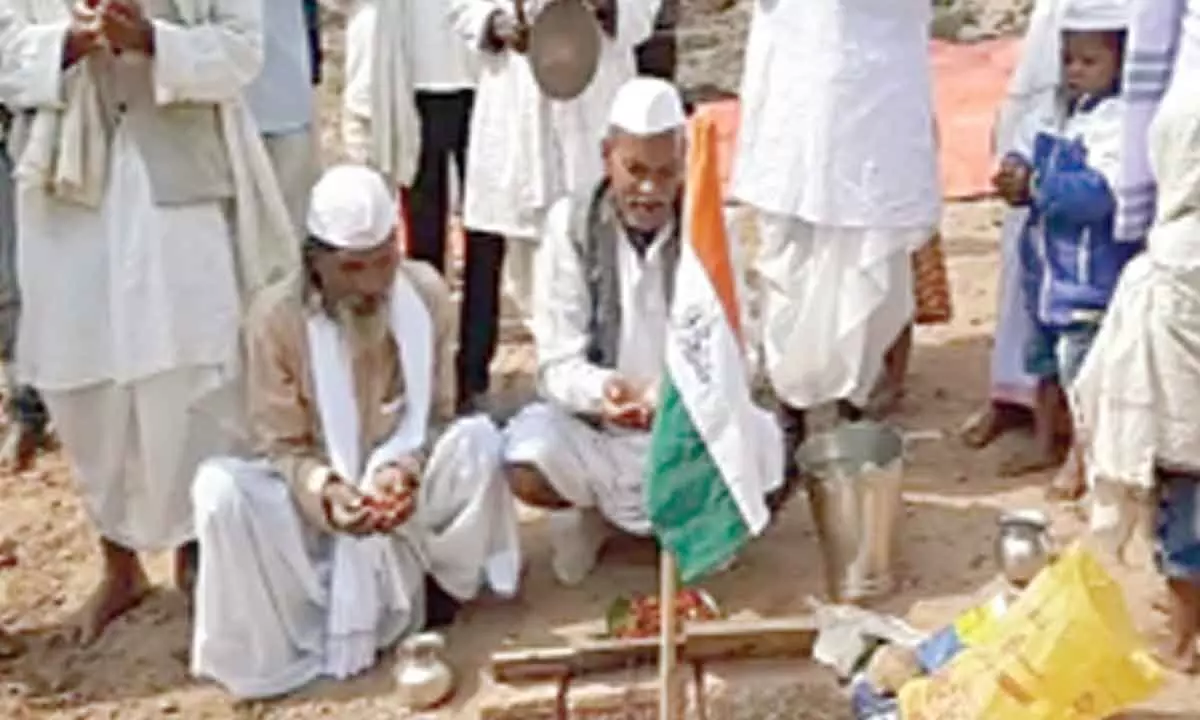Since 1917, this tribal community have been worshipping the Tricolour daily
image for illustrative purpose

Ranchi: Today, the whole country is enthusiastically observing the 'Azadi Ka Amrit Mahotsav' and 'Har Ghar Tiranga' campaign in view of the 75th anniversary of India's Independence, however, there is a tribal community that has been worshiping the Tricolour everyday for the past over 100 years.
The community, named 'Tana Bhagat' in Jharkhand, is so much devoted to the Tricolour that they take food and water every morning only after worshiping the flag.
The country became independent 75 years ago, but this community has been revering and worshiping the Tricolour as its supreme symbol and Mahatma Gandhi as a god-man since 1917. The Tricolour at their houses have the symbol of the spinning wheel inscribed instead of the Ashoka Chakra. This was the form of the Tricolour during the freedom movement. Since that time, this community has imbibed the mantra of 'Har Ghar Tiranga, Har Haath Tiranga'.
The imprint of Gandhi's ideals is so deep on this community that even today non-violence is the life mantra of this community. The people here have a simple lifestyle and do not consume non-vegetarian foods and alcohol. White Khadi clothes and Gandhi caps are their identity. Bigle Tana Bhagat, a resident of Saraiya village here in Chatra, says that the Tricolour with a spinning wheel is their (community's) religion.
Shivcharan Tana Bhagat, who studied till the second grade, says that the day begins with the worship of the Tricolour. "We eat pure vegetarian food after worshiping the Tricolour in the Puja Dham at our houses every day." In fact, Tana Bhagat is a cult, which was started by Jatra Oraon in 1914. He was a resident of a village named Chingari in Bishunpur block of Gumla district in the state.
Jatra Oraon started a campaign against animal-sacrifice, meat-eating, animal-killing, superstition of ghosts and alcohol consumption in the tribal society. He laid the formula of 'sattvik' life in front of the society. The campaign was effective. Those who followed this new lifestyle were termed as Tana Bhagats. Jatra Oraon also came to be known as Jatra Tana Bhagat.
In those days, the exploitation and atrocities by the British government were at its peak. Thousands of tribals, who joined the Tana Bhagat sect, had agitated against the feudal lords, moneylenders, missionaries besides British rule.
Jatra Tana Bhagat refused to pay taxes and do forced labour. The British government panicked and arrested Jatra Oraon in 1914. He was sentenced to one and a half years prison term. He died suddenly after being released from the prison, but the Tana Bhagat movement became associated with Mahatma Gandhi's Swadeshi movement due to its non-violent policy. Jatra Tana Bhagat had given the 'Guru Mantra' to his followers that do not demand food from anyone and adopt your identity with the Tricolour. It was only after this that the Tricolour became the supreme symbol of the Tana Bhagat sect and they began to consider Gandhi as a god-man. Gandhi's name is included in their traditional prayers till date.
Tana Bhagats participated in large numbers in the Gaya Conference of Congress in 1922 and Nagpur Satyagraha of 1923. In the Ramgarh Congress session of 1940, Tana Bhagats donated a bag with Rs 400 to Mahatma Gandhi.
Earlier in 1917, when Mahatma Gandhi and Dr. Rajendra Prasad came to Ranchi, they met Tana Bhagats. In 1926, under the leadership of Rajendra Prasad, an exhibition of Khadi was organised in the Arya Samaj Mandir in Ranchi, then Tana Bhagats also participated in it.
Tana Bhagats were also involved in the boycott of Simon Commission. When the country became independent, Tana Bhagats hoisted the Tricolour near their Tulsi Chaura (place in the courtyard of a house where sacred Tulsi plant is revered).
Even today, days like January 26, August 15 and October 2 are as auspicious as festivals for Tana Bhagats. They do not do any kind of agricultural work on these days. They get up in the morning and clean the village. After taking a bath, they hoist the national flag by singing the national anthem collectively.
Everyone chants slogans like 'Swatantra Bharat ki Jai, Mahatma Gandhi ki Jai, Rajendra Babu ki Jai and Tana Bhagat ki Jai'. They take out processions in the village and even distribute 'prasad'. There is a general meeting in the afternoon.
According to the documents of history, in 1914 about 26,000 people were followers of Tana Bhagat sect. Even today their number is around the same. When the Tana Bhagat movement started, the British government auctioned their land to suppress it. Even after the Independence, the government could not get them their land back. Even today, they continue to do non-violent agitations for their demand.
However, in 1948, the government passed the 'Tana Bhagat Rayat Agricultural Land Restoration Act'. In this Act, a provision was made to get back the lands of Tana Bhagats which were auctioned by the British government during the period from 1913 to 1942.
Ganga Tana Bhagat, former MLA of Mandar Assembly constituency of Ranchi, says, "Our community fought against the British for independence by leaving home, place, property, but it is sad that even after repeated promises of the governments, our community is being neglected."
The families of Tana Bhagats are mainly settled in different villages of Lohardaga, Gumla, Khunti, Ranchi, Chatra, Latehar, Simdega districts of the state.

